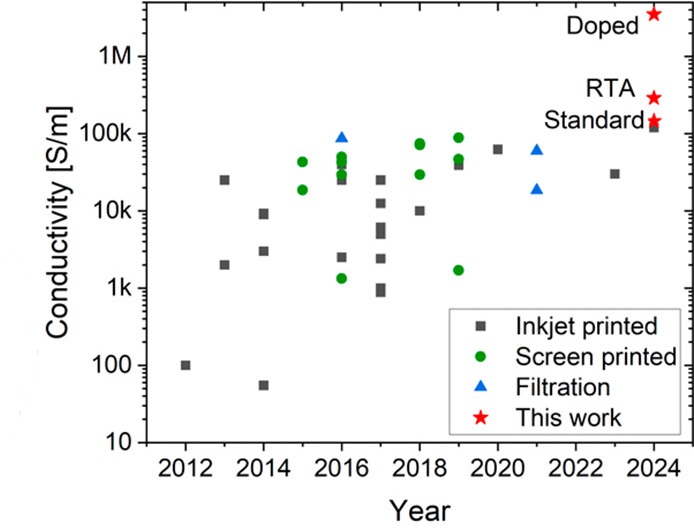Two new publications on novel lightweight conductors based on graphene and graphite
20.Feb.2025 Reseach News

We recently published
two new publications on novel lightweight conductors based on graphene and
graphite. The paper by Niemann et al. focusses on the improvment of the electrical
conductivity of graphitic films by transition metal additives. Graphite based
conductors are promising low cost and light-weight alternatives to copper but
current challenges are among others the improvement of the conductivity of
graphite films (GF). Therefore, in this work the influence of copper(II)
chloride and nickel(II) chloride on the graphitization of graphene oxide and
the electrical conductivity of the resulting GF was studied. The electrical
conductivity was measured at different scales by contactless eddy current
method and four point probe scanning tunneling microscopy transport measurements.
The macroscopic and nanoscopic transport measurements were complemented by
network-based simulations, which allowed us to estimate the microscopic
material properties of the GF with and without additives.
A second recent paper by Stevens et al. highlights the record conductivity of drop-casted graphen-based films. In this work, we report a stage-controlled wafer level
drop casting technique of thin graphene paths from a water based, additive free
graphene dispersion. The graphene dispersion was
cast onto wafer substrates up to 8 in. in size and annealed at 300 °C, achieving
0.14 × 106 S/m with controllable path
thicknesses down to 30 nm. The electrical conductivity can be significantly
increased to up to 3.5 × 106 S/m by gas-phase doping using
AlCl3. We discuss a doping
experiment, resulting in a gradual increase of conductivity between 2 and 30
times, underlined by EDX, Raman spectroscopy and profile measurements. Further,
we have modelled the graphene paths as an idealized layered system with many
flakes per layer, connected all flakes to form a conductor network, and finally
solved this network via nodal analysis. The reported results surpass previously shown
conductivities for dispersion casting of graphene by over an order of
magnitude, offering a sustainable alternative to replace metal-based conductors
in electronic devices.
